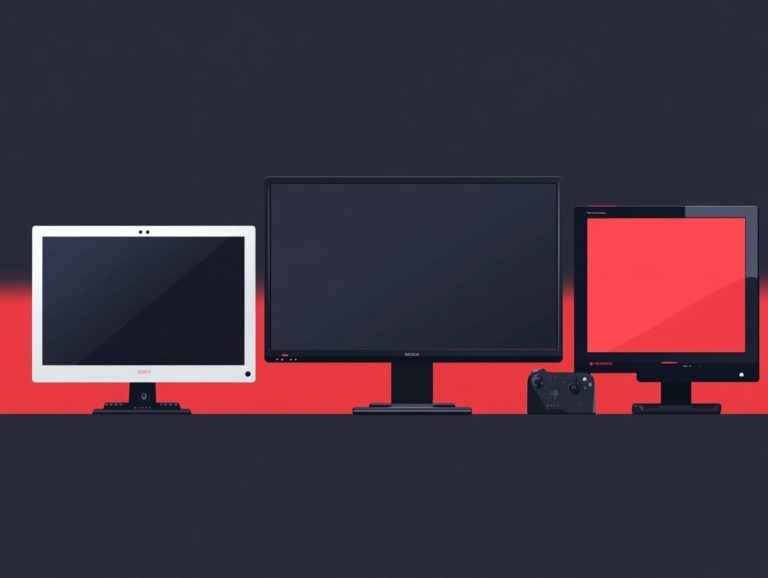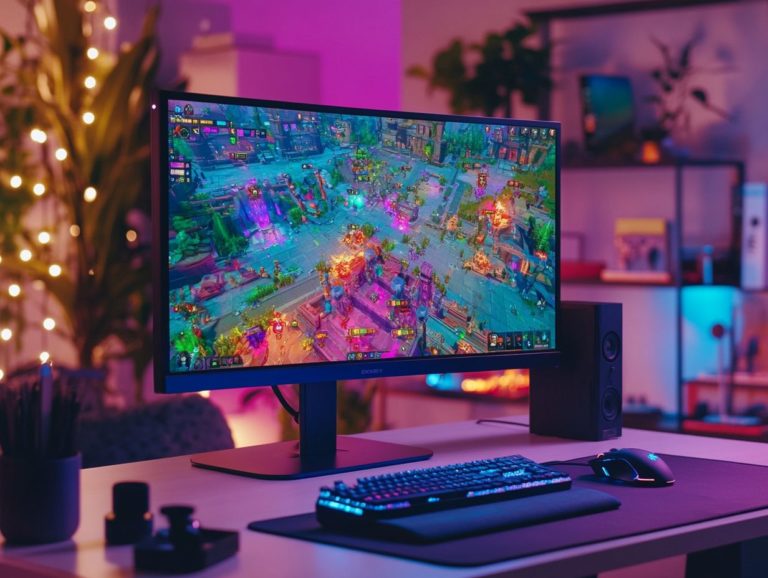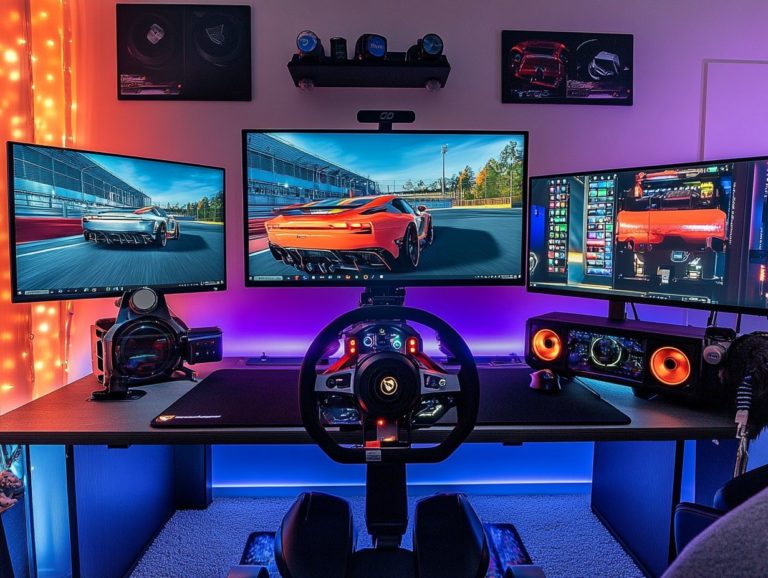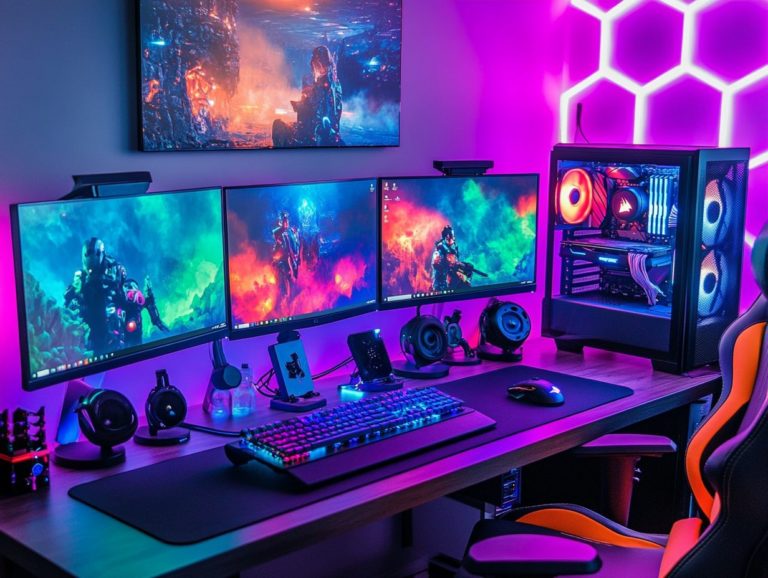best monitors for first-person shooter games
Picking the right monitor can supercharge your gaming experience, particularly for fast-paced first-person shooter (FPS) games.
With an array of features to consider from refresh rates and response times to color accuracy and ergonomic design understanding what to prioritize is essential.
This guide highlights the key elements that can enhance your gameplay, helping you find the perfect monitor whether you’re a seasoned player or just starting your FPS journey.
Prepare to transform your gaming setup into something truly exceptional!
Contents
- Key Takeaways:
- 1. High Refresh Rate and Low Response Time
- 2. Adaptive Sync
- 3. Resolution and Aspect Ratio
- 4. Panel Type
- 5. Size and Viewing Angle
- 6. Color Accuracy and Gamut
- 7. Input Lag and Motion Blur Reduction
- 8. Ergonomic Design
- 9. Price and Value for Money
- 10. Compatibility with Gaming Consoles
- How Do Monitors Affect Gaming Performance?
- What Are the Key Features to Look for in a Gaming Monitor?
- How Can a Gaming Monitor Enhance the FPS Gaming Experience?
- What Are the Most Popular Monitor Brands for FPS Gaming?
- How Can a Budget-Friendly Monitor Still Provide a Good Gaming Experience?
- What Are the Common Mistakes to Avoid When Choosing a Monitor for First-Person Shooter Games?
- Frequently Asked Questions
- What are the key features to look for in the best monitors for first-person shooter games?
- What is the ideal screen size for a monitor for first-person shooter games?
- Are curved monitors better for first-person shooter games?
- What is the recommended resolution for a monitor for first-person shooter games?
- Do I need a high refresh rate for a monitor for first-person shooter games?
- Can I use a TV as a monitor for first-person shooter games?
Key Takeaways:
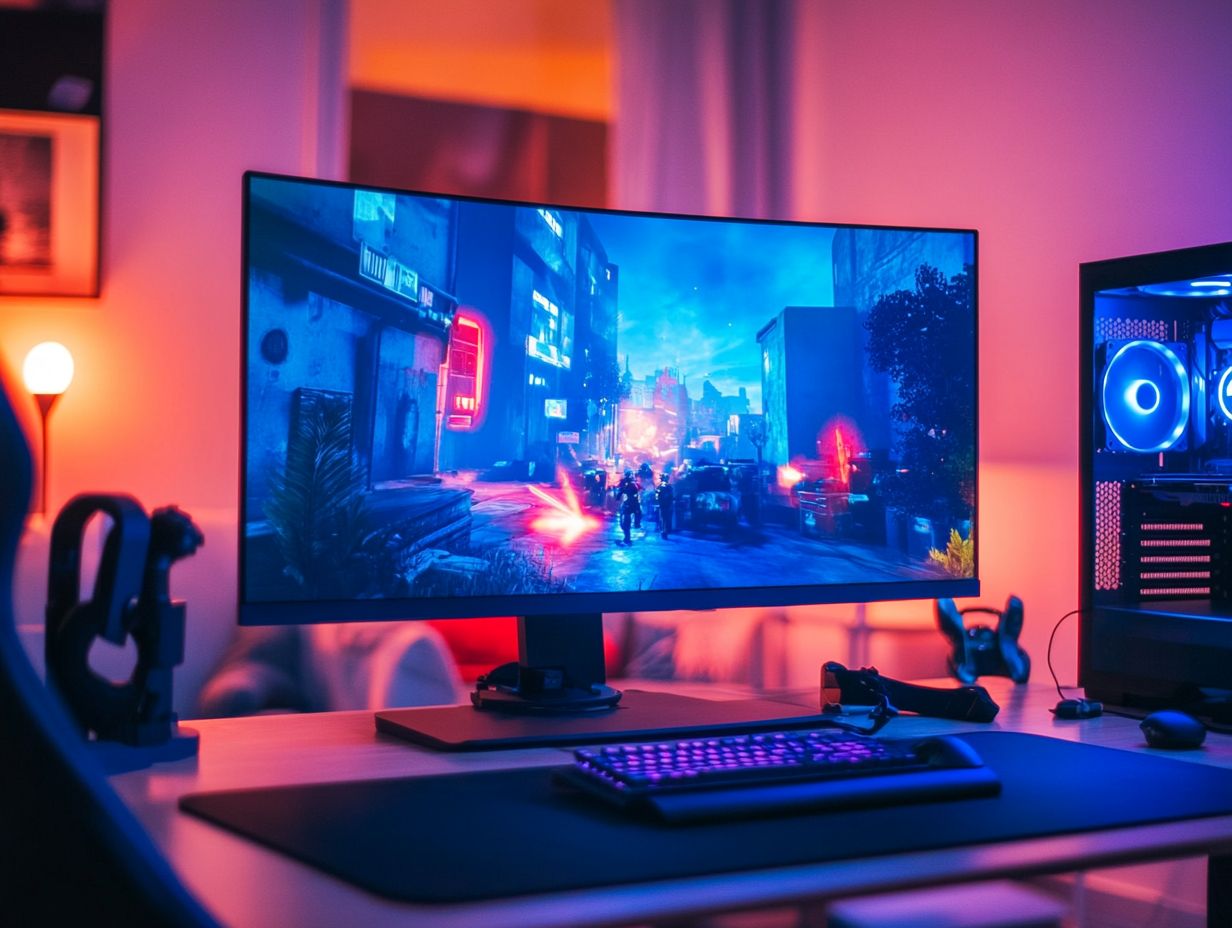
High refresh rate and low response time are crucial for smooth and responsive gameplay in FPS games. Look for a monitor with at least a 144Hz refresh rate and 1ms response time.
Adaptive Sync, such as AMD FreeSync or NVIDIA G-Sync, eliminates screen tearing and provides a seamless gameplay experience. Consider a monitor that supports this feature.
Resolution and aspect ratio affect your field of view and visual clarity in FPS games. Opt for a monitor with at least 1080p resolution and a 16:9 aspect ratio for a competitive advantage.
1. High Refresh Rate and Low Response Time
When selecting the ideal gaming monitor, you can’t overlook the importance of high refresh rates and low response times. These features elevate your gaming experience. This is especially true for fast-paced FPS games like Fortnite and Call of Duty.
They ensure smoother visuals and reduced ghosting, creating an immersive experience that can significantly enhance your gameplay performance.
With options ranging from 144Hz to a staggering 480Hz, you can tailor your setup to match your specific PC configuration and personal preferences.
For example, while a 144Hz monitor delivers fantastic performance for most gamers, if you’re deeply invested in competitive play, you might opt for a 240Hz or even a 360Hz display for that razor-sharp edge during gameplay.
Monitors like the ASUS ROG Swift PG259QN, with its impressive 360Hz refresh rate and 1ms response time, guarantee incredibly fluid motion and near-instant feedback essential for those lightning-fast reflexes.
Lower response times minimize motion blur, making critical in-game actions clear and crisp. Choosing the right monitor can indeed be the difference between victory and defeat, especially when split-second decisions hang in the balance.
By understanding these specifications, you can optimize your gaming environment for the ultimate experience.
2. Adaptive Sync
Adaptive Sync, including AMD FreeSync and NVIDIA G-SYNC, is essential for eradicating screen tearing and ghosting. Screen tearing happens when the monitor refreshes at a different rate than the graphics card, causing a jagged look on the screen. This technology provides you with a seamless and visually captivating experience during intense gaming marathons.
By aligning the refresh rates of your monitor with the frame rates of your graphics card, this technology ensures that every frame is delivered flawlessly, free from interruptions or jitter. Monitors with FreeSync or G-SYNC, such as the Dell Alienware AW2521H or the ASUS ROG Swift PG259QN, offer a significantly smoother gameplay experience.
This advantage is especially pronounced in fast-paced FPS games, where every millisecond truly matters. With Adaptive Sync, you gain a distinct edge, as the enhanced visual fluidity improves your ability to track moving targets, react swiftly, and fully immerse yourself in the action.
3. Resolution and Aspect Ratio
The resolution and aspect ratio of your gaming monitor are crucial elements that can dramatically elevate your image quality and visual immersion. You have a range of options, from standard 1080p to ultra-high-definition resolutions, ensuring you experience sharp and vibrant visuals.
Among these, 1080p, with its 16:9 aspect ratio, is a popular choice for those who want smooth performance without the need for high-end hardware. If you seek enhanced clarity and detail, consider stepping up to 1440p, which is especially beneficial for the rich graphics found in open-world games while retaining that same 16:9 ratio.
For the ultimate experience, 4K monitors offer incredible pixel density that can take your gaming to the next level. Just keep in mind that they demand more powerful GPUs to maintain high frame rates essential for competitive FPS games where every millisecond matters.
If you’re aiming to gain an edge, look for monitors with refresh rates of at least 144Hz. Models like the ASUS ROG Swift or Acer Predator series are particularly well-regarded for their adaptability across these resolutions, ensuring you get the most out of your gaming setup.
Ready to level up your gaming? Choose the perfect monitor today and unleash your full potential!
4. Panel Type
Different panel types IPS, OLED, VA, and TN each come with their own set of advantages and disadvantages.
- IPS: Great for vibrant colors and wide viewing angles.
- TN: Excellent for fast response times, ideal for competitive play.
- OLED: Stunning deep blacks and incredible contrast; watch for burn-in issues.
- VA: Offers excellent contrast ratios, perfect for darker environments, but may lag in response time.
By understanding these strengths and weaknesses, you can significantly enhance your gaming experience, tailoring it to suit your unique preferences.
5. Size and Viewing Angle
Choosing the right screen size and ensuring wide viewing angles is crucial for elevating your gaming experience. These elements significantly contribute to your comfort, immersion, and visibility during those marathon gaming sessions.
If you lean towards competitive play, a larger screen can enhance your responsiveness and boost your situational awareness.
On the flip side, casual gamers may find that smaller displays, especially those in the 24 to 27-inch range, provide sufficient visual clarity without feeling overwhelming.
In multi-monitor setups, appropriate viewing angles are vital. They can greatly influence teamwork and communication in cooperative games.
Ensuring everyone has a clear line of sight not only improves the gameplay experience but also enhances the social aspect, creating a more enjoyable atmosphere when gaming with friends.
6. Color Accuracy and Gamut
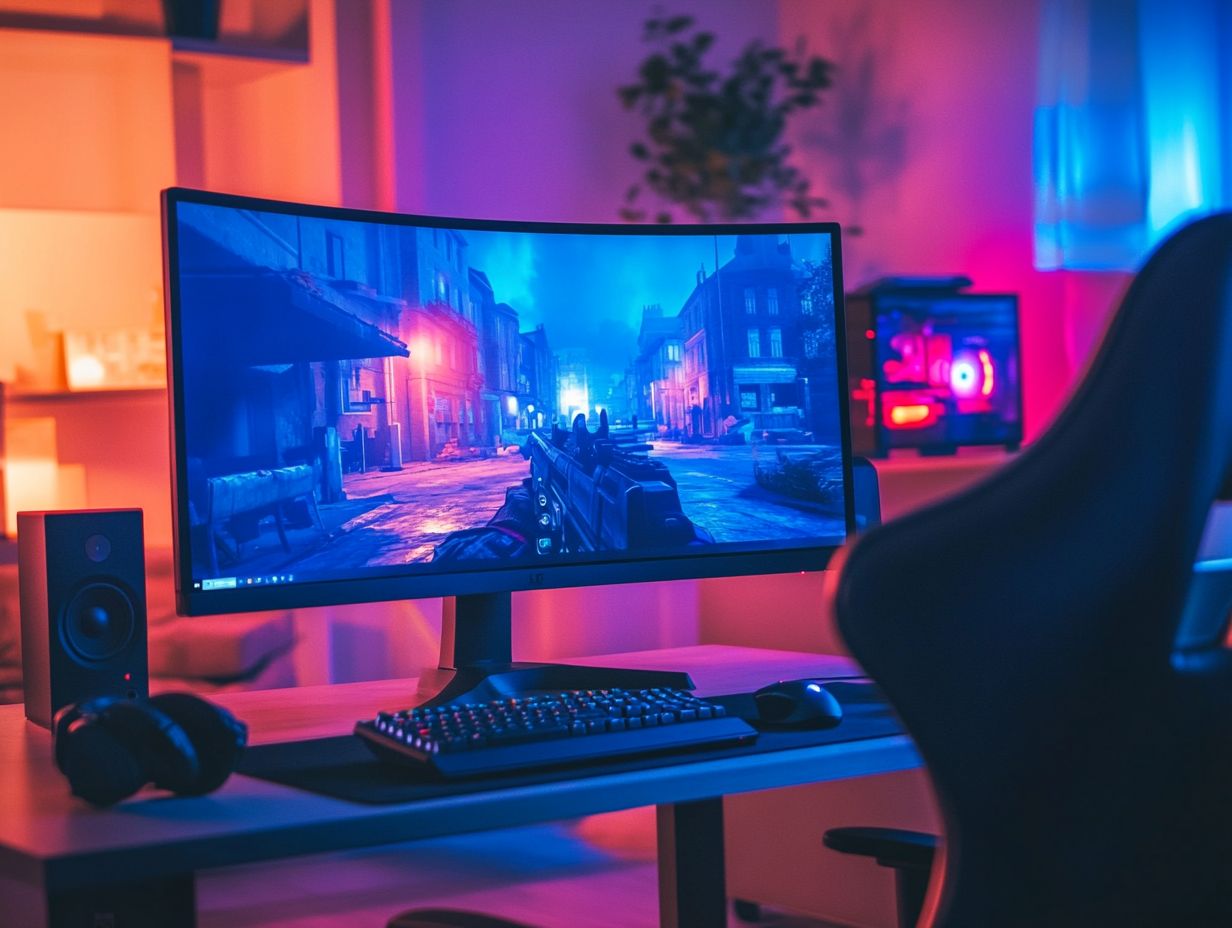
Color accuracy and a wide color gamut are crucial elements for your gaming monitors, significantly influencing image quality and realism. This enhancement lets you dive into the action!
When colors reflect real life, every explosion and character detail draws you deeper into the experience, enriching your overall gameplay.
Understanding the sRGB color space is essential; it defines the standard range of colors most devices use, ensuring games are displayed as the creators intended.
Peak brightness levels are vital for showcasing detailed highlights without sacrificing depth in shadows, making scenes come alive in a more dynamic way.
Monitors like the Dell Alienware AW3423DW and the ASUS ROG Swift PG32UQ shine in these aspects, offering remarkable color accuracy and impressive brightness.
7. Input Lag and Motion Blur Reduction
Input lag and motion blur reduction are crucial elements that can dramatically impact your gaming performance, especially in fast-paced FPS games.
Input lag refers to the delay between your action and what you see on the screen, while motion blur occurs when rapid movements cause images to blur.
When shopping for a monitor, seek options with minimal input lag and excellent motion blur reduction capabilities. Models like the Dell Alienware AW2521H and ASUS ROG Swift PG259QN are highly praised for their performance.
A responsive monitor can make the difference between winning and losing a game, providing a smoother, more enjoyable experience!
8. Ergonomic Design
An ergonomic design in gaming monitors elevates your comfort during marathon gaming sessions. It enhances visibility and minimizes strain, which is essential for serious gamers.
With adjustable stands, you can tailor the height and angle of your screen to suit your viewing preferences. This flexibility promotes a natural alignment of your neck and spine, reducing the risk of discomfort or injuries linked to poor posture.
Features like screen tilt help you find that perfect angle. Prioritizing ergonomic elements enriches your gameplay and safeguards your well-being, allowing you to enjoy your passion without physical strain.
9. Price and Value for Money
When shopping for a gaming monitor, grasping different price levels is essential. Evaluate the best value for your budget to ensure you make a savvy choice.
With numerous monitors available, understand how features like refresh rate, resolution, and response time affect prices. Entry-level options generally cater to casual gamers with standard refresh rates and resolutions.
If you seek a more serious option, mid-range monitors often provide higher refresh rates and improved color accuracy. Premium monitors feature cutting-edge technologies like G-Sync, which helps synchronize graphics for smoother gameplay.
To find budget-friendly options without sacrificing key gaming features, focus on reputable brands that offer slightly older models. They often deliver impressive performance at more accessible prices.
10. Compatibility with Gaming Consoles
When picking the best gaming monitor for console gaming, compatibility with popular consoles like Xbox is crucial. Look for key ports such as dual HDMI and DisplayPort; these ensure seamless gameplay with stunning visuals and minimal input lag.
The ability to switch between multiple devices is critical. This flexibility lets you immerse yourself in various gaming worlds effortlessly.
Features like low refresh rates and high dynamic range can enhance your experience. Imagine the thrill of stunning visuals that make every moment more engaging!
As you explore options, consider premium models like the ASUS ROG Swift or the Samsung Odyssey series. These monitors not only have exceptional compatibility with the latest consoles but also deliver breathtaking image quality.
Don t settle for less! Check out the ASUS ROG Swift or Samsung Odyssey series for an unbeatable gaming experience.
How Do Monitors Affect Gaming Performance?
Monitors play a crucial role in gaming performance. They influence factors like refresh rates, input lag, and image quality deciding moments between triumph and defeat in competitive gaming.
A higher refresh rate offers smoother animations and responsiveness, essential for fast-paced games like “Call of Duty” or “Apex Legends,” where every millisecond matters.
Reduced input lag significantly enhances your precision in gameplay. Titles like “Street Fighter V” or “Fortnite” become not just more enjoyable but also much more competitive.
A 144Hz monitor combined with minimal input lag gives you a distinct advantage over opponents using standard displays.
Investing in quality monitor specifications can revolutionize your gaming experience, leading to improved performance and deeper immersion.
What Are the Key Features to Look for in a Gaming Monitor?
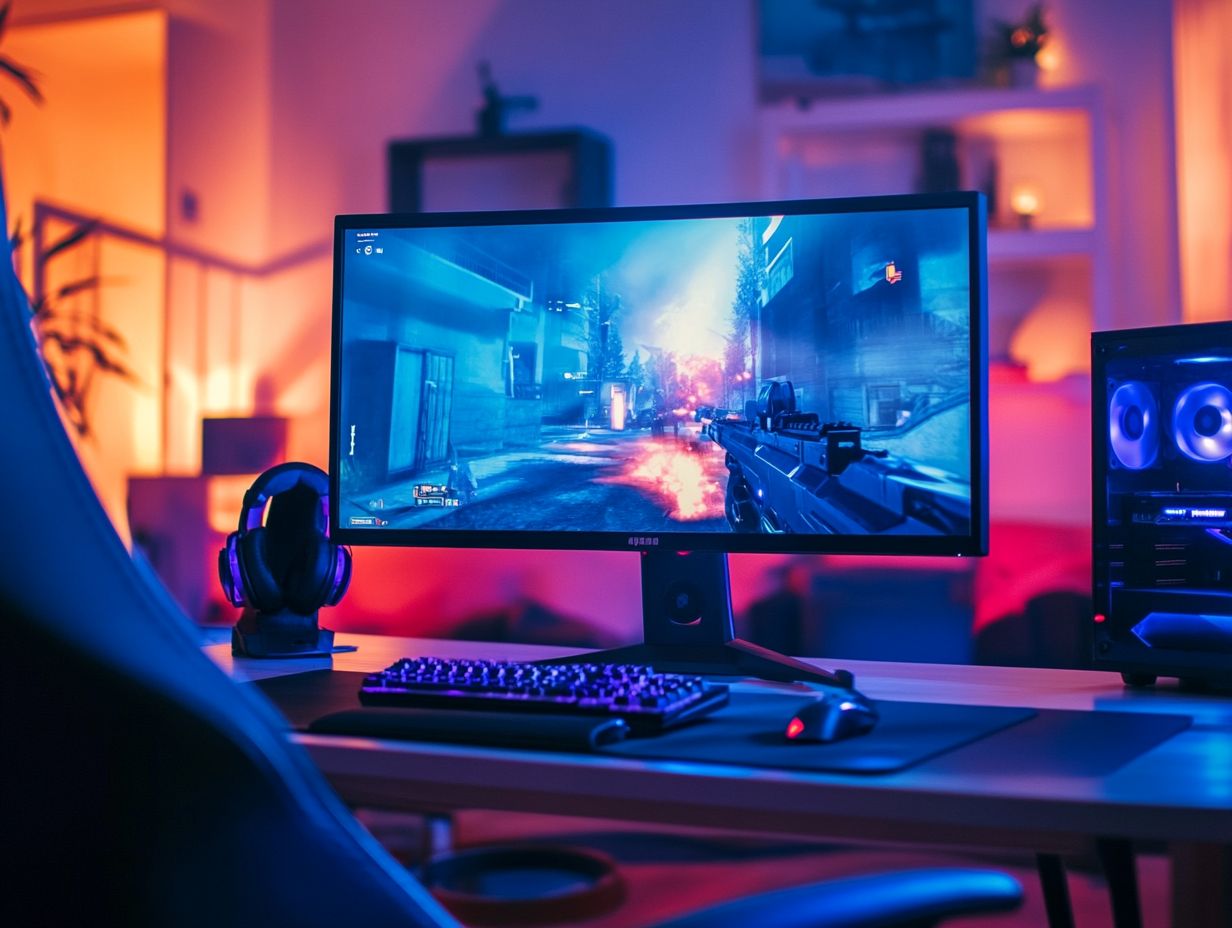
When you’re on the hunt for the perfect gaming monitor, there are several key features you should prioritize. These include refresh rates, resolution, and adaptive sync technology, which helps ensure smoother gameplay by synchronizing the monitor’s refresh rate with the graphics card’s output.
The type of panel matters significantly. Options like IPS, VA, and TN panels offer different levels of color accuracy and response times, impacting both visual quality and performance.
Fine-tuning your ergonomics with adjustable height and tilt functions can make a world of difference in comfort. This is especially true during those long gaming marathons.
Opting for a higher resolution ensures you get sharp images and immersive details. A high refresh rate minimizes motion blur, delivering smoother visuals during fast-paced gameplay.
Combining these elements creates an environment that’s not just enjoyable but also competitive. This allows you to truly immerse yourself in your gaming world.
How Can a Gaming Monitor Enhance the FPS Gaming Experience?
A dedicated gaming monitor can transform your FPS gaming, making every match more thrilling! Choosing the best monitors for 3D gaming offers higher refresh rates, lower input lag, and superior image quality—essential elements for competitive play.
Choosing a monitor with a refresh rate that surpasses the standard 60Hz means you ll enjoy buttery-smooth visuals. This makes tracking fast-moving targets and reacting swiftly during intense firefights a breeze.
The benefit of low input lag ensures that every keystroke or mouse movement translates into immediate on-screen action. This is crucial when every millisecond counts.
Top-tier monitors provide enhanced color accuracy and contrast levels, allowing you to spot details in shadowy corners that might otherwise escape your notice. Investing in an exceptional gaming monitor not only boosts your performance in FPS titles but also enhances your enjoyment. For more insights, check out how to set up your gaming monitor for fps games.
What Are the Most Popular Monitor Brands for FPS Gaming?
When it comes to FPS gaming, popular monitor brands like BenQ, ASUS, Acer, and LG are excellent choices. If you’re into racing games, you might want to check out the best monitors for racing games, as each of these brands offers models specifically designed to elevate your gaming experience.
These brands have set the standard in the gaming community through their dedication to high refresh rates, low response times, and vibrant color accuracy.
Take BenQ s flagship Zowie XL series, for example. It s a favorite among players for its innovative dyAc technology, which significantly reduces motion blur and gives you a competitive edge in fast-paced scenarios.
ASUS’s ROG Swift series features G-Sync compatibility, ensuring your gameplay is smoother and free from screen tearing. Acer s Predator series is celebrated for its impressive refresh rates, reaching up to 240Hz, making it a powerhouse for serious gamers.
Let s not forget LG s UltraGear monitors, which shine with stunning IPS technology. They deliver breathtaking visuals without compromising speed, making them a top pick for competitive gamers like you.
How Can a Budget-Friendly Monitor Still Provide a Good Gaming Experience?
Even if you’re on a budget, you can discover monitors that deliver excellent value and performance. This ensures an enjoyable gaming experience without emptying your wallet.
While these budget-friendly options might not have every high-end feature, they offer essential qualities. These include decent refresh rates and acceptable image quality, with some models achieving refresh rates of 144Hz, enhancing responsiveness during fast-paced games.
Monitors like the AOC 24G2 and the Acer XFA240 are exceptional choices. They stand out for their affordability while providing vibrant colors and sharp images.
With these economical monitors, you can dive into immersive FPS action. Check out the top 5 monitors for competitive gaming that strike the perfect balance between cost and performance, aligning seamlessly with your budget constraints.
What Are the Common Mistakes to Avoid When Choosing a Monitor for First-Person Shooter Games?
When choosing a monitor for first-person shooter games, it is easy to fall into common traps, such as overlooking refresh rates, prioritizing aesthetics over performance, and ignoring ergonomic design. Similarly, for those into fighting games, selecting the best monitors for fighting games is crucial for an optimal experience.
These missteps can dramatically affect your gameplay, leading to frustrating moments where every millisecond truly matters. A higher refresh rate is essential, offering smoother visuals during those intense situations that demand split-second reactions.
A flashy design may distract you from crucial specifications like response time and the delay between your action and what you see on screen. Make sure to grab adjustable stands that promote better posture during those lengthy gaming marathons, helping you avoid discomfort and maintain focus.
By redirecting your attention to these performance features, you can create a more responsive and enjoyable gaming experience.
Frequently Asked Questions
What are the key features to look for in the best monitors for first-person shooter games?
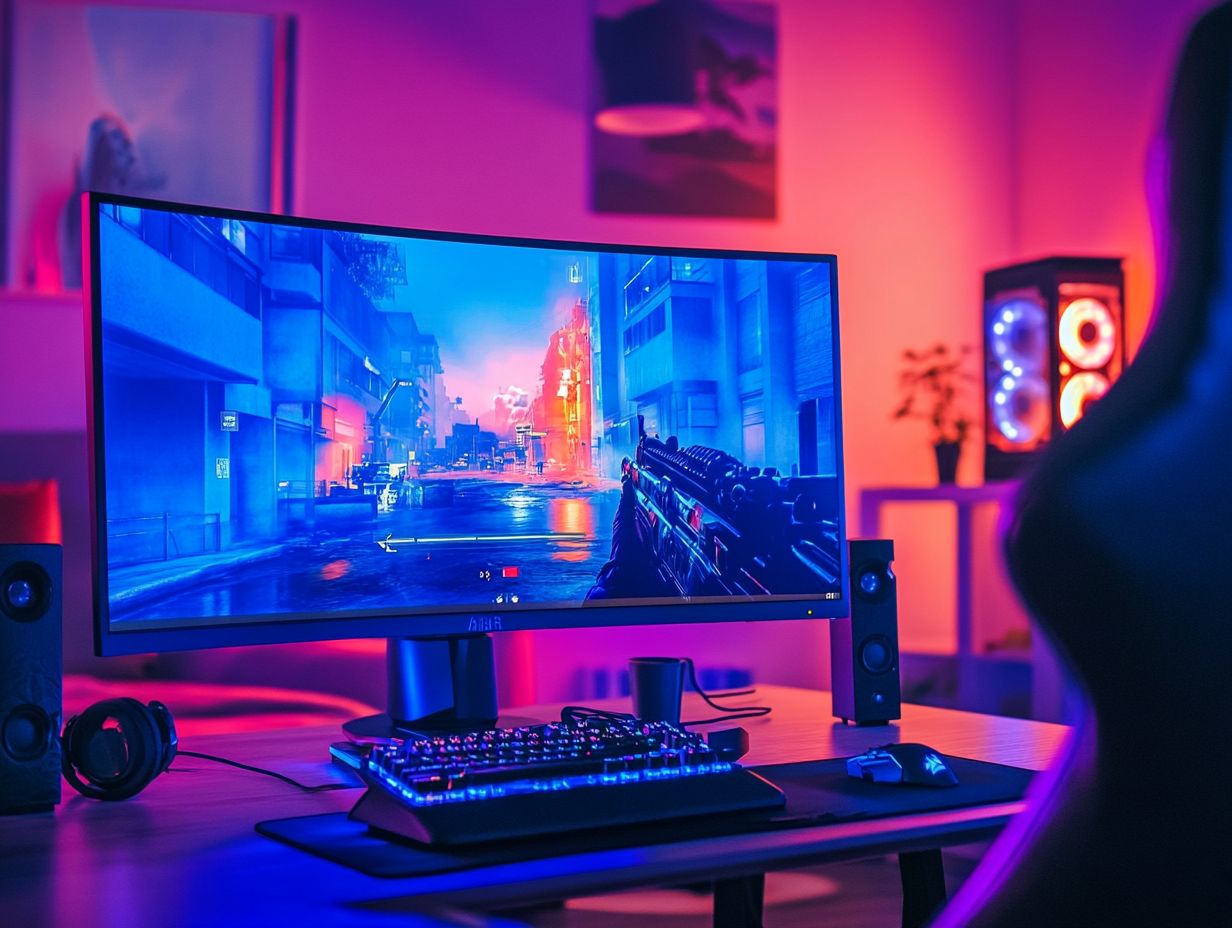
The best monitors for first-person shooter games should have a high resolution, fast response time, high refresh rate, and low input lag. For those also interested in the best monitors for strategy games, similar features are essential for an optimal gaming experience.
What is the ideal screen size for a monitor for first-person shooter games?
The ideal screen size for a monitor for first-person shooter games is between 24 to 27 inches. For RPG gamers, however, exploring the best monitors for RPG gaming can significantly enhance immersion and improve reaction time!
Are curved monitors better for first-person shooter games?
Curved monitors can provide a more immersive gaming experience, but they do not necessarily improve gameplay for first-person shooter games. It ultimately comes down to personal preference.
What is the recommended resolution for a monitor for first-person shooter games?
The recommended resolution for a monitor for first-person shooter games is 1080p or higher, especially if you’re looking for one of the top monitors for esports enthusiasts. This will provide sharper and more detailed visuals.
Do I need a high refresh rate for a monitor for first-person shooter games?
Yes, a high refresh rate of at least 144Hz is recommended for first-person shooter games. This allows for smoother and more responsive gameplay.
Can I use a TV as a monitor for first-person shooter games?
While it is possible to use a TV as a monitor for first-person shooter games, it is not ideal. TVs generally have lower refresh rates and higher input lag, which can negatively impact gameplay. It is best to use a monitor specifically designed for gaming.
Choosing the right monitor is crucial for enhancing your gaming experience. Make informed decisions and enjoy your next game!

